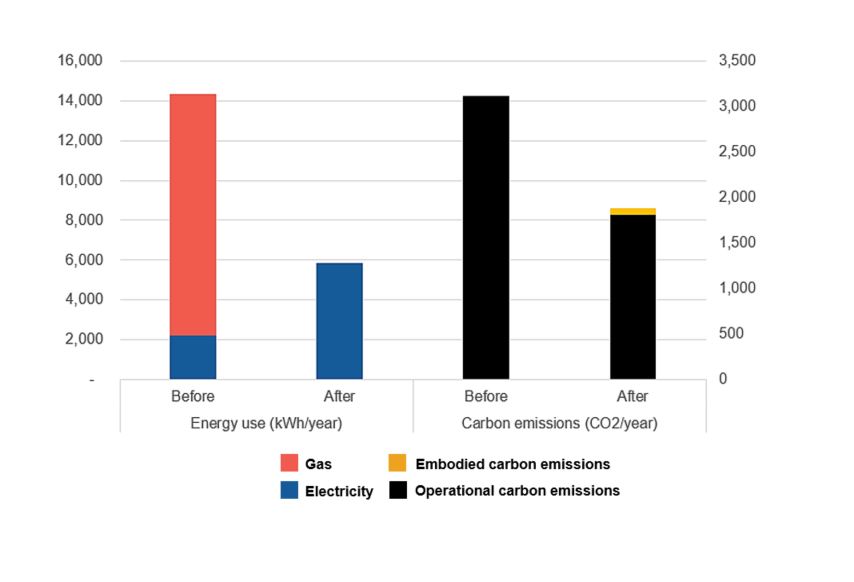After installing a new air source heat pump in my home, I posted a photo on Twitter, delighted about the carbon emissions we will save. My celebration, however, was short-lived. The post triggered an intense discussion with many people feeling that my decision to replace my six-year-old gas condensing boiler was unjustifiable. “Ripping out a perfectly well functioning gas boiler before the end of its natural life and replacing it with a heat pump is misguided. It won’t reduce much carbon.”
Of course, I had calculated the likely energy and carbon savings prior to the installation, but this and similar arguments made me realise the importance of digging deep into carbon emission issues (and any climate change issues, for that matter). Numbers need putting to the test and results need monitoring.
Rather than replacing an old, decrepit heating system with a new one, which is the main reason for installing a new heating system, I decided to remove the perfectly functional boiler installed by the previous owner.
We were already in the middle of major building work to extend our kitchen. With builders on site and our house in a state of disruption, it made sense to think seriously about our future heating system now.
I live in the UK, where more than 26 million boilers are installed, mainly running on gas. All will need to be replaced with low-carbon heating technologies if we are to reach a net-zero carbon emissions target. Feeling a sense of urgency, I decided to decarbonise our home’s energy use now, learn from it and inspire others to follow suit. We still install 1.6 million gas boilers a year in the UK compared to just 22,000 heat pumps, which are mostly in new buildings. Progress on stopping global warming is too slow, as the recent net-zero report from the Climate Change Committee highlighted.
But does it really make sense to replace a relatively new gas boiler with a heat pump? Let’s take a look at the impact the heat pump will have on carbon emissions. My energy use is expected to go down by as much as 60%. This is because a heat pump delivers about three units of heat using one unit of energy generated from ambient heat. A gas boiler delivers about 0.9 units of heat for one unit of energy. Being conservative, I calculated the carbon emissions from my heat pump using marginal emission factors for electricity, which are more appropriate for small changes in demand.
In 2019, the marginal emissions for each kilowatt hour of electricity use are 308 grams carbon dioxide equivalent (g CO2e). This figure is projected by the UK government to decline to just 130 g CO2e by 2030, which is 36% cleaner than gas. So not only does a heat pump use significantly less energy, it also uses a fuel that is getting cleaner. As a result, I have already reduced carbon emissions in my home by 42%. Coupled with solar panels, which I plan to install next, I expect to drive even steeper carbon reductions.
But what about the embodied carbon emissions of the new heat pump? Would it not be better to wait until a heating system has reached the end of its life before replacing it? In response to my Twitter post, someone suggested to me that “knee jerk installations of heat pumps over natural gas boilers ‘to save CO2’ are not done until the useful life of the gas boiler has been met. Premature boiler changes will cause more CO2 than they will save.”
Here again, the numbers support the early retirement of gas boilers. The total embodied carbon emissions for a typical air source heat pump installed in a UK home are 1,563 kg CO2e. My heat pump avoids 1,313 kg CO2e per year. It means that after less than 1.5 years, a heat pump starts saving carbon compared to a gas boiler, even if the gas boiler is replaced before the end of its life. Hence, from a carbon perspective, it makes sense to replace a gas boiler even if it was just installed. Assuming a 20-year lifetime for the heat pump, the embodied carbon emissions per year are just 78 kg CO2e per year, or 4% of the operational carbon emissions from fuel use.
Impact of heat pump on energy consumption and carbon emissions. With all of this said, it is important to note that installing a heat pump in isolation in existing, and often inefficient, homes is not advisable. I have made an argument elsewhere for aligning energy efficiency and heat decarbonisation to maximise carbon reduction and avoid oversized heating systems. This is why we invested in energy efficiency measures in our Victorian 1880s home alongside the heat pump. We insulated the floor throughout, installed mostly triple or double glazing and insulated the attic.
With all of this said, it is important to note that installing a heat pump in isolation in existing, and often inefficient, homes is not advisable. I have made an argument elsewhere for aligning energy efficiency and heat decarbonisation to maximise carbon reduction and avoid oversized heating systems. This is why we invested in energy efficiency measures in our Victorian 1880s home alongside the heat pump. We insulated the floor throughout, installed mostly triple or double glazing and insulated the attic.
Finally, let’s not forget that this is not a new idea. We support renewable energy technologies to speed up coal plant retirement. Efficiency programs support replacing “perfectly good” light bulbs and even compact fluorescents with new LEDs. Utility demand-side management programmes across the globe have “cash for clunkers” programmes to replace old fridges that are still in working order.
I learned a lot from taking a hard look at my own energy consumption and carbon emissions. I will monitor our energy use carefully over the coming year, compare the figures I calculated with real data, and report back once I have data for a whole year using the new system. With more energy efficiency improvements to come, I hope to beat my predictions and achieve an even lower carbon home.
A version of this article originally appeared onFORESIGHT Climate and Energy.Photo: GEO PLC

